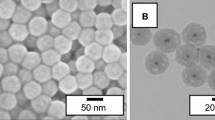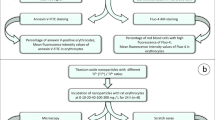Abstract
In the past decade, a variety of drug carriers based on mesoporous silica nanoparticles has been extensively reported. However, their biocompatibility still remains debatable, which motivated us to explore the porous nanostructures of other metal oxides, for example titanium dioxide (TiO2), as potential drug delivery vehicles. Herein, we report the in vitro hemolysis, cytotoxicity, and protein binding of TiO2 nanoparticles, synthesized by a sol–gel method. The surface of the TiO2 nanoparticles was modified with hydroxyl, amine, or thiol containing moieties to examine the influence of surface functional groups on the toxicity and protein binding aspects of the nanoparticles. Our study revealed the superior hemocompatibility of pristine, as well as functionalized TiO2 nanoparticles, compared to that of mesoporous silica, the present gold standard. Among the functional groups studied, aminosilane moieties on the TiO2 surface substantially reduced the degree of hemolysis (down to 5%). Further, cytotoxicity studies by MTT assay suggested that surface functional moieties play a crucial role in determining the biocompatibility of the nanoparticles. The presence of NH2– functional groups on the TiO2 nanoparticle surface enhanced the cell viability by almost 28% as compared to its native counterpart (at 100 μg/ml), which was in agreement with the hemolysis assay. Finally, nonspecific protein adsorption on functionalized TiO2 surfaces was examined using human serum albumin and it was found that negatively charged surface moieties, like –OH and –SH, could mitigate protein adsorption to a significant extent.

ᅟ






Similar content being viewed by others
References
Aisaka Y, Kawaguchi R, Watanabe S (2008) Hemolysis caused by titanium dioxide particles. Inhal Toxicol 20:891–893
Avgoustakis K (2004) Pegylated poly(lactide) and poly(lactide-coglycolide) nanoparticles: preparation, properties and possible applications in drug delivery. Curr Drug Delivery 1:321–333
Cai R, Kubota Y, Shuiyn T, Sakai H, Hashimoto K, Fujishima A (1992) Induction of cytotoxicity by photoexcited TiO2 particles. Cancer Res 52:2346–2348
Chen J, Dong X, Zhao J, Tang G (2009) In vivo acute toxicity of titanium dioxide nanoparticles to mice after intraperitoneal injection. J Appl Toxicol 29:330–337
Du J, Gebicki JM (2004) Proteins are major initial cell targets of hydroxyl free radicals. Int J Biochem Cell Biol 36:2334–2343
Ehrlich V, Darroudi F, Uhl M, Steinkellner S, Zsivkovits M, Knasmeuller S (2002) Fumonisin B1 is genotoxic in human derived hepatoma (HepG2) cells. Mutagenesis 17:257–260
Fogh-Andersen N, Bjerrum PJ, Siggaard-Andersen O (1993) Ionic binding, net charge, and Donnan effect of human serum albumin as a function of pH. Clin Chem 39:48–52
Ghosh M, Chakraborty A, Mukherjee A (2013) Cytotoxic, genotoxic and the hemolytic effect of titanium dioxide (TiO2) nanoparticles on human erythrocyte and lymphocyte cells in vitro. J Appl Toxicol 33:1097–1110
Ghosh S, Majumder D, Sen A, Roy S (2014) Facile sonochemical synthesis of zinc oxide nanoflakes at room temperature. Mater Lett 130:215–217
Gogniat G, Thyssen M, Denis M, Pulgarin C, Dukan S (2006) The bactericidal effect of TiO2 photocatalysis involves adsorption onto catalyst and the loss of membrane integrity. FEMS Microbiol Lett 258:18–24
Han W, Wag Y, Zheng Y (2009) In vivo biocompatibility studies of nano TiO2 materials. Adv Mater Res 79-82:389–392
He Q, Zhang J, Shi J, Zhu Z, Zhang L, Bu W, Guo L, Chen Y (2010) The effect of PEGylation of mesoporous silica nanoparticles on nonspecific binding of serum proteins and cellular responses. Biomaterials 31:1085–1092
Hoffmann MR, Martin ST, Choi W, Bahnemann DW (1995) Environmental applications of semiconductor photocatalysis. Chem Rev 95:69–96
Huang N, Yang P, Leng YX, Chen JY, Sun H, Wang J, Wang GJ, Ding PD, Xi TF, Leng Y (2003) Hemocompatibility of titanium oxide films. Biomaterials 24:2177–2187
Jacobs JF, Poel I, Osseweijer P (2010) Sunscreens with titanium dioxide (TiO2) nanoparticles: a societal experiment. NanoEthics 4:103–113
Jin CY, Zhu BS, Wang XF, Lu QH (2008) Cytotoxicity of titanium dioxide nanoparticles in mouse fibroblast cells. Chem Res Toxicol 21:1871–1877
Kluson P, Kacer P, Cajthaml T, Kalajic M (2001) Preparation of titania mesoporous materials using a surfactant-mediated sol–gel method. J Mater Chem 11:644–651
Lin YS, Haynes CL (2010) Impacts of mesoporous silica nanoparticle size, pore ordering, and pore integrity on hemolytic activity. J Am Chem Soc 132:4834–4842
Méndez-vivar J, Mendoza-Serna R, Gómez-Lara J, Gaviño R (1997) Spectroscopic study of SiO2-TiO2 sols prepared using stabilizing agents. J Sol-Gel Sci Technol 8:235–241
Murashov V, Harper M, Demchuk E (2006) Impact of silanol surface density on the toxicity of silica aerosols measured by erythrocyte haemolysis. J Occup Environ Hyg 3:718–723
Nobuo U (1971) Isoelectric points and conformation of proteins: effect of urea on the behavior of some proteins in isoelectric focusing. BBA-Protein Struct 229:567–581
Otsuka H, Nagasaki Y, Kataoka K (2003) PEGylated nanoparticles for biological and pharmaceutical applications. Adv Drug Deliv Rev 55:403–419
Owens DE, Peppas NA (2006) Opsonization, biodistribution, and pharmacokinetics of polymeric nanoparticles. Int J Pharm 307:93–102
Patil S, Sandberg A, Heckert E, Self W, Seal S (2007) Protein adsorption and cellular uptake of cerium oxide nanoparticles as a function of zeta potential. Biomaterials 28:4600–4607
Popov AP, Priezzhev AV, Lademann J, Myllylä R (2005) TiO2 nanoparticles as an effective UV-B radiation skin-protective compound in sunscreens. J Phys D Appl Phys 38:2564
Prencipe G, Tabakman SM, Welsher K, Liu Z, Goodwin AP, Zhang L, Henry J, Dai H (2009) PEG branched polymer for functionalization of nanomaterials with ultralong blood circulation. J Am Chem Soc 131:4783–4787
Reeves JF, Davies SJ, Dodd NJF, Jha AN (2008) Hydroxyl radicals (*OH) are associated with titanium dioxide (TiO2) nanoparticle-induced cytotoxicity and oxidative DNA damage in fish cells. Mutat Res-Fund Mol M 640:113–122
Salgin S, Takac S, Ozdamar TH (2006) Adsorption of bovine serum albumin on polyether sulfone ultrafiltration membranes: determination of interfacial interaction energy and effective diffusion coefficient. J Membr Sci 278:251–260
Selloni A, Vittadini A, Gratzel M (1998) The adsorption of small molecules on the TiO2 anatase (101) surface by first-principles molecular dynamics. Surf Sci 402-404:219–222
Shi H, Magaye R, Castranova V, Zhao J (2013) Titanium dioxide nanoparticles: a review of current toxicological data. Part Fibre Toxicol 10:15
Sigal GB, Mrksich M, Whitesides GM (1998) Effect of surface wettability on the adsorption of proteins and detergents. J Am Chem Soc 120(14):3464–3473
US Food and Drug Administration (2014) CFR-Code of Federal Regulations, Title 21, vol 1 and 5. http://www.accessdata.fda.gov/scripts/cdrh/cfdocs/cfcfr/CFRSearch.cfm?fr=73.575. Revised as of 1 Apr 2014
Vallet-Regí M, Balas F, Arcos D (2007) Mesoporous materials for drug delivery. Angew Chem 46:7548–7558
Wang J, Zhou G, Chen C, Yu H, Wang T, Ma Y, Jia G, Gao Y, Li B, Sun J, Li Y, Jiao F, Zhao Y, Chai Z (2007) Acute toxicity and biodistribution of different sized titanium dioxide particles in mice after oral administration. Toxicol Lett 168:176–185
Weir A, Westerhoff P, Fabricius L, Hristovski K, Goetz N (2012) Titanium dioxide nanoparticles in food and personal care products. Environ Sci Technol 46:2242–2250
Yang HG, Zeng HC (2004) Creation of intestine-like interior space for metal-oxide nanostructures with a quasi-reverse emulsion. Angew Chem Int Ed 43:5206–5209
Ye L, Mao J, Liu J, Jiang Z, Peng T, Zan L (2013) Synthesis of anatase TiO2 nanocrystals with {101}, {001} or {010} single facets of 90% level exposure and liquid-phase photocatalytic reduction and oxidation activity orders. J Mater Chem A 1:10532–10537
Yildirim A, Demirel GB, Erdem R, Senturk B, Tekinay T, Bayindir M (2013a) Pluronic polymer capped biocompatible mesoporous silica nanocarriers. Chem Commun 49:9782–9784
Yildirim A, Ozgurab E, Bayindir M (2013b) Impact of mesoporous silica nanoparticle surface functionality on hemolytic activity, thrombogenicity and non-specific protein adsorption. J Mater Chem B 1:1909–1920
Yin JJ, Liu J, Ehrenshaft M, Roberts JE, Fu PP, Mason RP, Zhao BZ (2012) Phototoxicity of nano titanium dioxides in HaCaT keratinocytes—generation of reactive oxygen species and cell damage. Toxicol Appl Pharmacol 263:81–88
Yokoyama M, Okano T, Sakurai Y, Ekimoto H, Shibazaki C, Kataoka K (1991) Toxicity and antitumor activity against solid tumors of micelle-forming polymeric anticancer drug and its extremely long circulation in blood. Cancer Res 51:3229–3236
Zhang Y, Kohler N, Zhang M (2002) Surface modification of superparamagnetic magnetite nanoparticles and their intracellular uptake. Biomaterials 23:1553–1561
Zhang X, Bai R, Tong YW (2006) Selective adsorption behaviors of proteins on polypyrrole-based adsorbents. Sep Purif Technol 52:161–169
Zhao Y, Sun X, Zhang G, Trewyn BG, Slowing II, Lin VS (2011) Interaction of mesoporous silica nanoparticles with human red blood cell membranes: size and surface effects. ACS Nano 5:1366–1375
Author information
Authors and Affiliations
Corresponding author
Ethics declarations
Conflict of interest
The authors declare that they have no conflict of interest.
Rights and permissions
About this article
Cite this article
Datta, A., Dasgupta, S. & Mukherjee, S. Modifications of nano-titania surface for in vitro evaluations of hemolysis, cytotoxicity, and nonspecific protein binding. J Nanopart Res 19, 142 (2017). https://doi.org/10.1007/s11051-017-3835-5
Received:
Accepted:
Published:
DOI: https://doi.org/10.1007/s11051-017-3835-5




